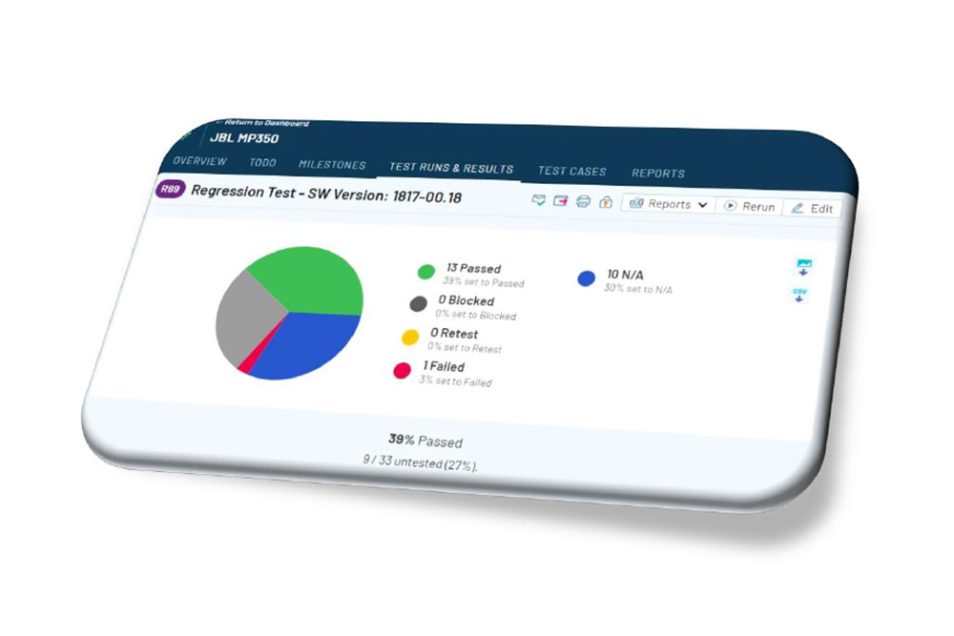Tech Talk
Test Management Tools - The Benefits
By Roberta Macri | Product Test Engineer

Introduction
No matter how simple or complex a project may be, to date we have ascertained that TESTING to ensure quality must always be part of the process.
However, the inclusion of this phase in the software development life cycle is not enough, it’s how it is organized that will make the difference. And this is true for each phase of course! How the team is planning to perform its tasks, will impact the final product quality, human resources, effort, timing, costs, and consequently to the company’s success.
It is not difficult to realize that, especially in the tech world, precision, and efficiency in the creation of the final product plays a great role in the achievement of the objectives set. To ensure that this is guaranteed, it is essential that the team has everything it needs, tools as well! Improvement of the quality of test activities by allowing for more consistent testing and higher level of defect reproducibility is one of the purposes of a Test Tool, depending on the context of course, as Test Tools have been developed for different phases of the Test Process. This article is an overview of the benefits of using a Test Management Tool. From ISTQB (International Software Testing Qualifications Board) Glossary:
“A tool that provides support to the test management and control part of a test process. It often has several capabilities, such as testware management, scheduling of tests, the logging of results, progress tracking, incident management and test reporting”.
Here we are!
And so, Test Management Tools have taken hold, replacing our dear Excel spreadsheet (which in past years has been very popular for managing such activities) beating it on several fronts: efficient content creation, traceability, maintenance, reusability of that content, professional reporting, proficient teamwork in a centralized platform, reduced cost, better quality.

So, what’s the big deal?
There are many Test Management Tools available, each one with its own look and features. However, some key points remain common to all of them:
- Test Cases (creation, editing, maintenance, reusability)
Test case creation is now a smooth process, the interface with all necessary fields already labelled speeds up the activity’s flow. Updates can be easily applied to one or more test cases at the same time. They can be copied or moved as well, making simple reuse possible whenever different projects or test suites share some characteristics. What if you need to share them? Import and export options are usually available.
- Test Run (ad hoc test suite creation, progress tracking, testing coverage)
When test cases have been added, and the product finally has something testable, then it’s the turn of the Test Run. A specific template for this purpose makes this phase very easy and intuitive to be planned, run and completed.
-
- Test cases selection: What are you going to test? What’s the scope? It is very common to have the necessity to test only a specific impacted area, or only one functionality, or test cases with a specific priority. Time and resources are precious, no one want to risk wasting them and loose the main focus of an activity. Selecting only test cases needed (that could belong to different test suite) and creating a customized Test Run can be done with few quick ticks and click! The result is a well-defined plan, implemented quickly, moving the effort to things that matter more!
-
- Assignment and Teamwork: What if a task needs more than one tester involved? Specific test cases can be assigned to a specific tester. The possibility to face conflict, overlap, time waste in double testing items by mistake and misunderstanding will be reduced to a minimum. Test Management Tools facilitate the organization of collaborative work with the team, by sharing the same working environment.
- Test Run: Let’s start! Test cases can be re-ordered e.g., by Priority. There's no point in starting with cosmetic checks if a functional feature is broken, right? It is very useful to start your work from critical test cases first, as needed. This will give a good chance to notice high-impact failures in your project as soon as possible. Each test case can be marked with the actual status (Untested, Passed, Blocked, Retest, Failed, N/A are the available ones TestRail). Current Testing results will be tracked in an efficient way: key colours, charts, coverage indication in percentage and more, allow understanding of the test work status at first glance.
- Test Report (communication, reporting)
Test completed? Well done! In the “Test Completion” phase, test results documentation can now be shared with relevant stakeholders, in order to proceed with the next link in the chain. Customized and professional reports can be generated with one click, with different formats as needed. Visual elements like intuitive charts also help to clarify the general situation here. What if tests have not been completed yet, and the current status needs to be shared, to keep the team informed about a certain situation? Important communications cannot wait, they must be promptly made to make the right decisions in time. Well, report can be always generated to keep your team updated.
Doesn’t it sound great?
Above are only some of the strong points of Test Management Tools, but it seems it is already enough to appreciate the efficiency and the accuracy with which some parts of the testing work can be done. By automating many aspects of the testing process, the amount of time and effort required to complete testing is reduced. This, in turn, reduces costs, as fewer resources are needed for testing. Also, by catching defects earlier in the development process, Test Management Tools help reduce the cost of fixing defects later as well.
Could all those features be implemented, and tasks be performed through simple files, scripts, git, and cloud…? Yes of course, we already did it in the past! But why not embrace automation where it allows us to improve the efficiency of our work? Think about this: while we can all appreciate the charm and elegance of a beautiful handwritten letter, no office today could function without email!

